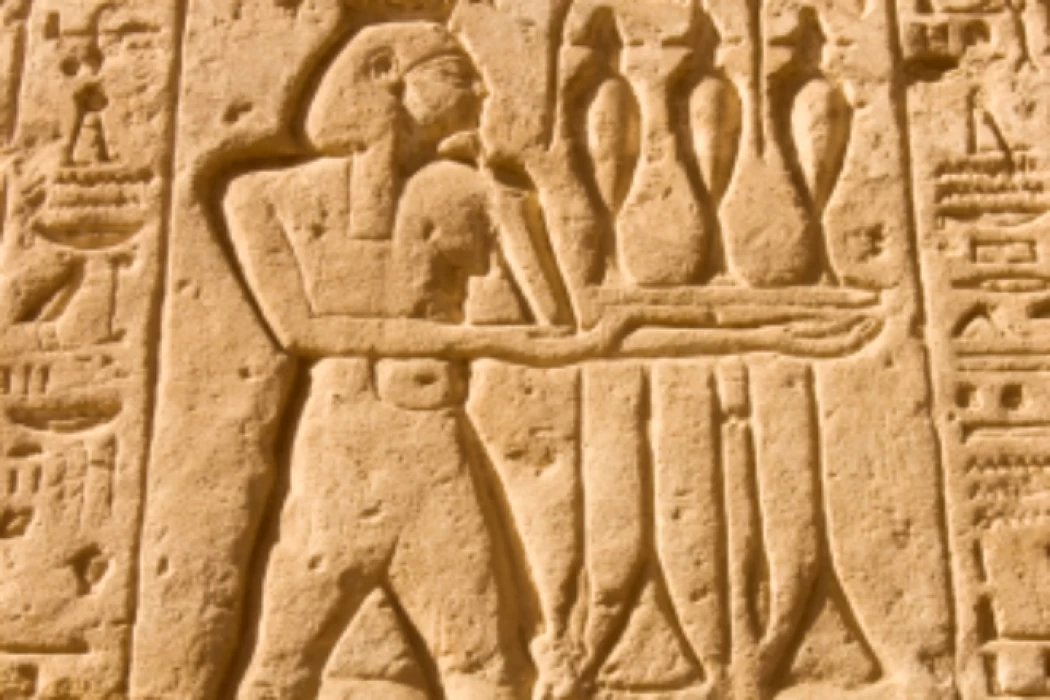
El Dios del Nilo Hapi | El Dios de la Fertilidad | El Dios del Norte y del Sur
Los historiadores dicen que Hapi (Hapy, Hap, Hep) era muy probablemente un nombre prehistórico del propio río Nilo. Esto ocurrió cuando la gente empezó a adorarlo como la deidad de la inundación anual del río. Más tarde, la gente cambió el nombre a Nilo o Itero, que significa "río". De ahí que los antiguos egipcios también cambiaran el nombre del dios del Nilo por el de "El Río" o Itero.
Para entenderlo mejor, la palabra egipcia "Nwy" significa agua. El nombre "Nilo" proviene de la corrupción griega de "Neilos", derivada de "Nwy". La gente dio a Hapi otros títulos, como "Señor de los peces y las aves del pantano" y "El verde de las dos orillas". La gente también le llamaba "el hacedor de la cebada y el trigo" y "el dueño del río que trae la vegetación". Al igual que otras deidades romanas y griegas, la mitología considera que Hapi tenía una personalidad benévola y bondadosa. Sin embargo, también tenía un lado oscuro que podía causar una destrucción imprevisible. También se afirma que la deidad actuaba bajo la influencia del faraón, que también era una deidad viviente. Además, los textos lo describen como "Siddik Geb", el dios egipcio de la tierra y "Rab Nabar", el dios del grano.
La crecida del Nilo debida al "Diluvio" era tan vital para la vida y la economía de Egipto que los antiguos basaban su vida en ella. Cada año, una enorme cantidad de agua se desborda por las orillas del Nilo y deja un limo negro. Con él se mantiene la agricultura en Egipto y se alimenta a la población.
La historia se refiere a esta crecida anual como la "Llegada de Hapi". La gente celebraba este acontecimiento con grandes festivales y organizaba procesiones en el río. Seguidores de todo el mundo viajaban a los santuarios de Hapi de Elefantina y Asuán. Rezaban para que la crecida y el limo les ayudaran a cultivar.
Historians say that Hapi (Hapy, Hap, Hep) was most likely a prehistoric name for the Nile River itself. It happened when people began to worship him as the deity of the annual flood of the river. Later on, people changed the name to Nile or Itero, which means "river". Hence, the ancient Egyptians also changed the name of the Nile god to “The River” or Itero.
To better understand this, the Egyptian word “Nwy” means water. The name “Nile” comes from the Greek corruption of “Neilos,” derived from “Nwy.” People gave Hapi other titles, including "Lord of the Fish and the Birds of the Marsh" and "The Green of the Two Banks". People also called him “the maker of barley and wheat” and “the master of the river that brings vegetation.” Like other Roman and Greek deities, mythology believes Hapi to have a benevolent and good-natured personality. However, he also had a dark side that could cause unpredictable destruction. People also claim that the deity worked under the influence of the pharaoh, who was also a living deity. Moreover, the texts describe him as “Siddik Geb,” the Egyptian god of the earth and “Rab Nabar,” the god of grain.
The flooding of the Nile due to the "Flood" was so vital to the life and economy of Egypt that the ancients based their lives around it. Every year a huge amount of water overflows the banks of the Nile and leaves black silt. It will support agriculture in Egypt and keep people fed.
The history refers to this annual flood as the "Arriving of Hapi". People celebrated this event with great festivals and organized processions on the river. Followers from all over the world would travel to the Hapi shrines of the Elephantine and Aswan. They were praying for the right amount of flood and silt to help them grow their crops.
One can only imagine the respect and devotion they would have for the Nile flood god. Hapi's importance leads to some people worshiping him above the powerful sun god Ra. The deity controlled the waters of the Nile itself and thus affected the well-being of millions of people.
People gave or removed some Hapi traits according to the region in which they live. In Lower Egypt, the god was dressed in papyrus, and was attended by frogs. In contrast, Upper Egypt had an abundance of lotuses and crocodiles. Hence, the people of the region associated the symbols of both with Hapi. People rarely used the blue hippopotamus to depict the deity.
Many images depict Hapi as carrying offerings of food or pouring water from a jug. Nineteenth-century iconography depicts hapi as a pair of figures connecting and linking together the stems of two plants. These plants represent Upper and Lower Egypt. This description connects the two sections around the union symbol.
The people of Hapi in Upper Egypt called Hap-Meht, while the Lower Egyptians called Hapi Hap-Reset. One can find this symbolic representation carved into the base of statues of the seated pharaoh. For example, one can find a stone carving of Hapi in the Luxor Temple on either side of a seated statue of Ramesses II. Also, you can spot images of Hapi on the Colossus of Memnon in the Temple of Amenhotep III.
There are no temples for the god Hapi, but one can find many statues and reliefs of the god in the temples of other gods. People worshiped the god all over the land of Egypt, but they revered him most in Swenet and Gebel el-Silsilah. The people worshiped Khnum, Satit and Ankot in Elephantine with the god Hapi. His priests on Elephantine Island had a nilometer to measure and monitor the levels of the Nile.
Statues of the god Hapi are found in many places, the most famous of which is the statue in Britain. Another statue I extracted myself from the Temple of Ramses II in Akhmim is a magnificent representation of Egypt's southern and northern faces.
Another statue is located in the Temple of Abu Simbel. Murals and images of Hapi are found in all Egyptian temples, given his sanctity to all Egyptians and his association with the sacred river, which Pharaonic legends said was the result of the tears of the goddess Isis.















